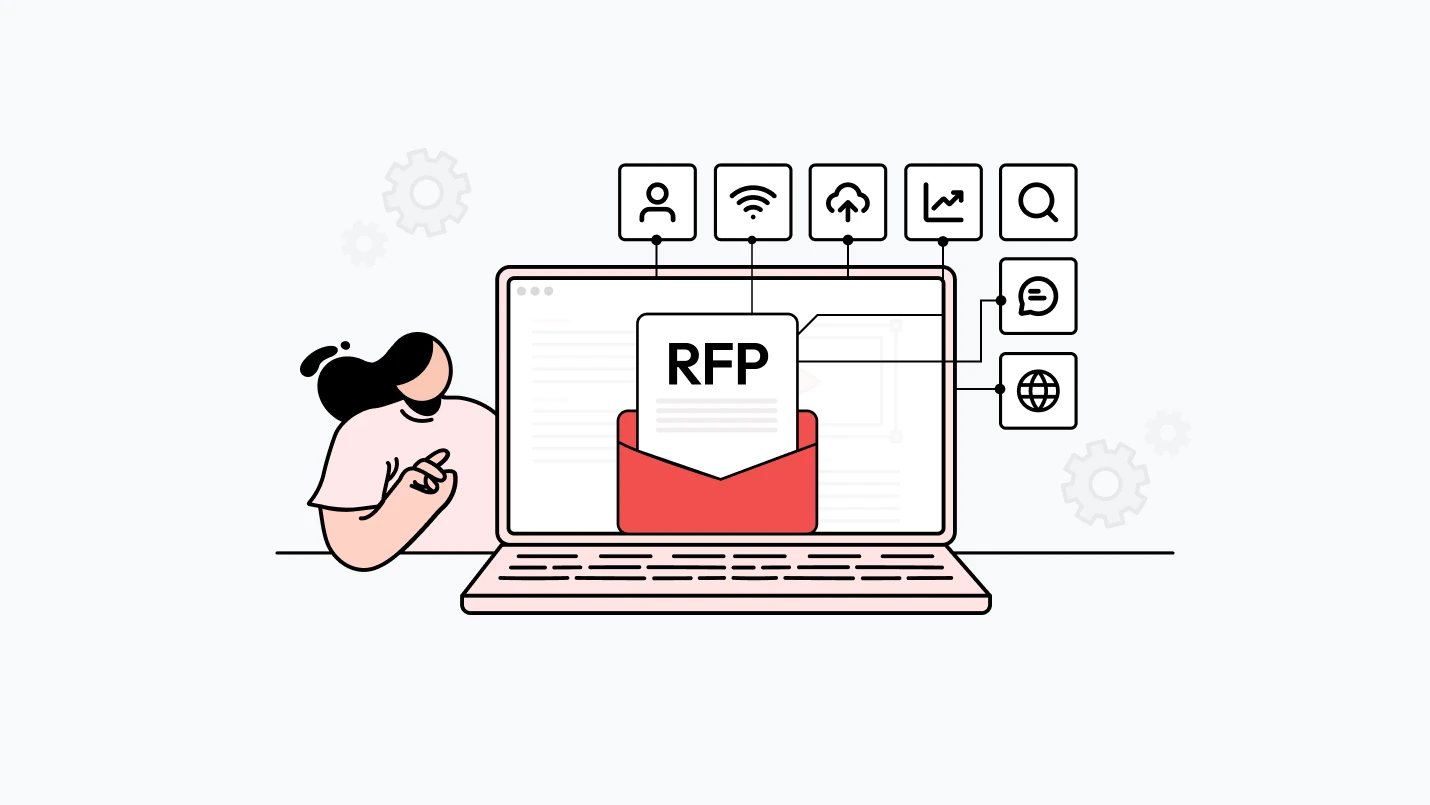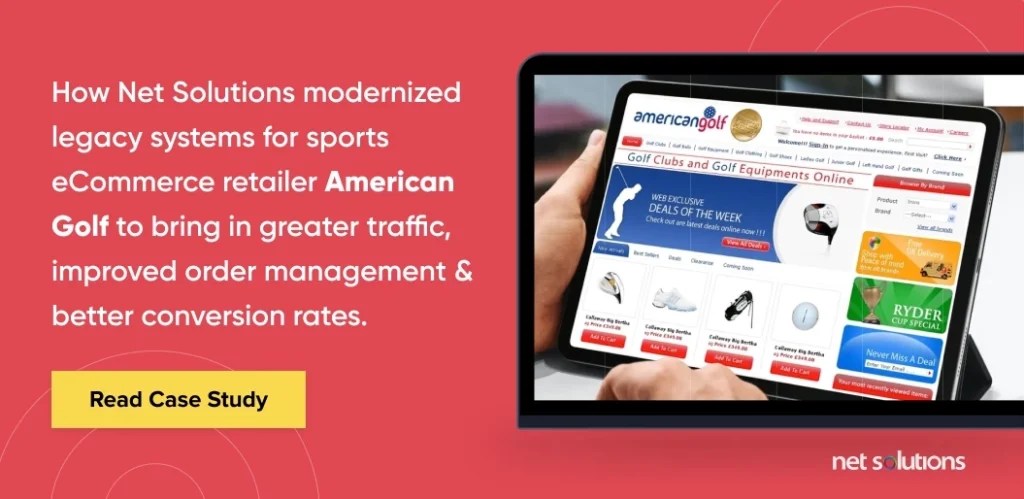A powerful Information Technology (IT) infrastructure is a must-have in today’s complex, interconnected world. If you need a Managed Service Provider (MSP) to take care of some or all of your IT needs, a Request for Proposal (RFP) can help in your search for potential vendors.
You’ve got a lot of options when it comes to outsourcing partners, but not all companies that handle managed IT services are created equal. Different companies have different specialties, so it’s important to identify your business needs and only entertain partnerships with those who can meet them.
This blog will help you decide whether an RFP might help in your selection process, and it provides key information that will assist you in creating your RFP, if you decide to go down that path.
Are you looking for an experienced Managed Services Provider? Net Solutions has decades of experience supporting the IT needs of companies across the globe. Contact us!
Do You Need an RFP for IT Services?
Many companies create an RFP simply because it’s company policy—part of their procurement process—and that’s not necessarily a good reason. After all, RFPs are time-consuming to create, and there may be better ways to invest your time.
You might also be tempted to create an RFP when you’re just looking for information and surveying the market, but in that case, you’re probably better off creating a Request for Information (RFI). We’ll talk more about RFIs below.
Others might consider creating an RFP when they’re looking for price quotes, comparing current vendor prices (IT services cost, in this case) with competitor pricing to negotiate a better deal. In that case, you don’t need to create an RFP because a Request for Quotation (RFQ) would work just fine.
When should you write an RFP? We’ll explore this question in greater detail below, but the short answer is that you should only take the time to write an RFP for IT services when you’ve got a reasonably clear understanding of the challenges you face.
Of course, that doesn’t mean you have to know all the solutions! In fact, an RFP can be particularly helpful when you understand the problems you face and you’re open to hearing suggestions from vendors about how they can help.
Benefits of a Request for Proposal for IT services
RFPs come with many benefits when used for the right reasons. Here are some of the benefits of writing an RFP for IT services.
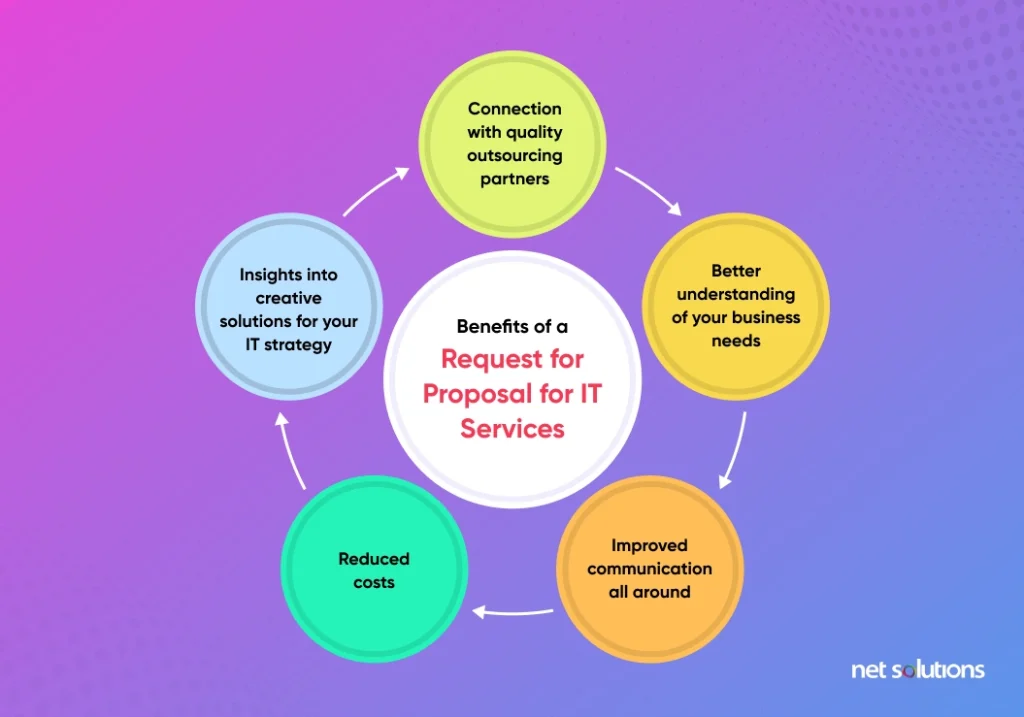
A few of the benefits of writing an RFP include:
- Selecting high-quality suppliers: An RFP that is written strategically, providing carefully considered selection criteria, will help connect you with quality outsourcing partners.
- Clarity of vision: The RFP process itself can help you better understand your business needs and deliverables, drawing your attention to the best use of your resources.
- Improved communication: Writing an RFP can help you communicate your needs to prospective partners as well as internal teams.
- Reduced Cost: An RFP lets you collect competitive pricing bids from different vendors.
- Insights into solutions: By laying out your service requirements, you can solicit solutions from RFP respondents, giving you greater insights into your IT strategy.
When to reconsider creating an RFP
As we mentioned above, RFPs are time-consuming and labor-intensive to create. Writing an RFP makes sense when:
- You have a clear understanding of the challenges you face
- You’re ready to contract with a vendor soon
- You are interested in gaining insights and solutions from prospective partners
When these criteria are met, it makes sense to start working on an Information Technology RFP.
IT Services RFP Structure
Every RFP should contain certain key elements that communicate important information about your project, your company, your goals, and what you’re looking for from a provider.
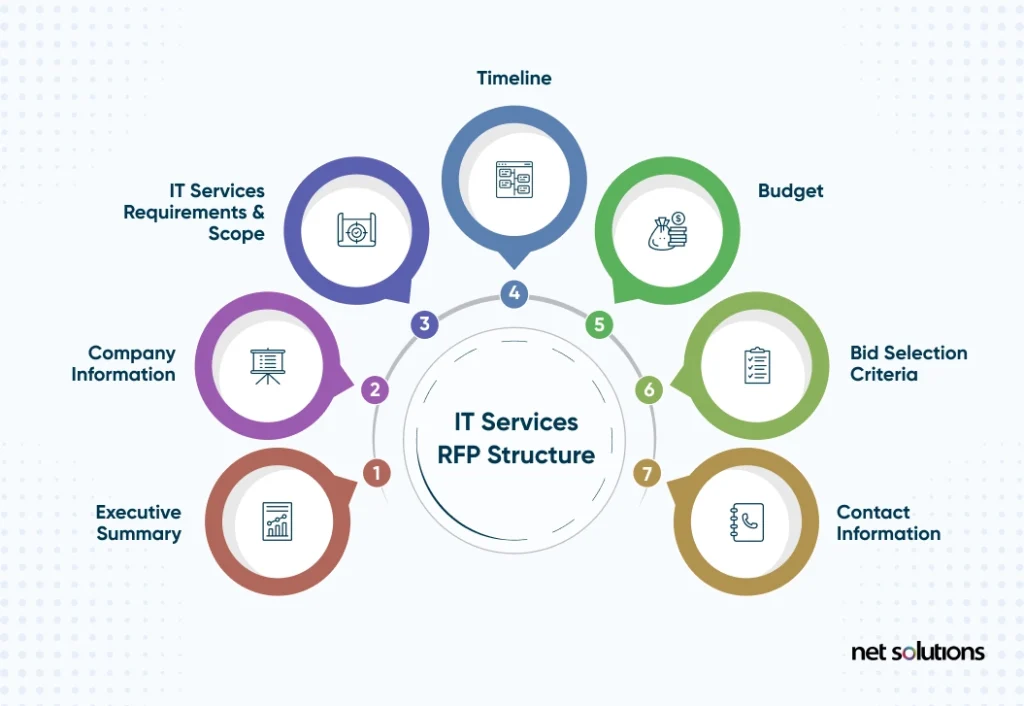
Here’s a breakdown of how to structure your RFP for IT Services, along with what to include in each section.
- Executive summary: Give potential vendors a broad overview of the services you’ll need to solicit from them and what you’re trying to accomplish.
- Company information: Provide your company name, a description of what your company does, what its IT needs are, and what brings you to solicit outside support from IT providers. Include any background information relevant to the project.
- IT Services requirements and scope: Are you looking to outsource your entire IT management? Or are you looking to supplement your in-house team’s work by providing services such as IT support or security? Outline your needs here.
- Timeline: What time-sensitive projects do you have planned, and what are the timelines?
- Budget: What is your budget for IT services?
- Bid selection criteria: What is your evaluation criteria for selecting IT partners? Spell that out in this section so IT companies can highlight their strengths and experience.
- Contact information: Provide a contact name, email, and/or phone number for the point of contact who can answer questions and receive proposals.
How to Issue an IT Services RFP
There’s an ideal process for issuing an RFP for IT services, and it isn’t something you want to do casually or last-minute. It involves meeting with stakeholders at your organization and developing a strategy to ensure you’ve outlined all your needs.
The following seven steps will help you clarify your needs, understand your options, clearly articulate your needs, and review your options before making a decision.
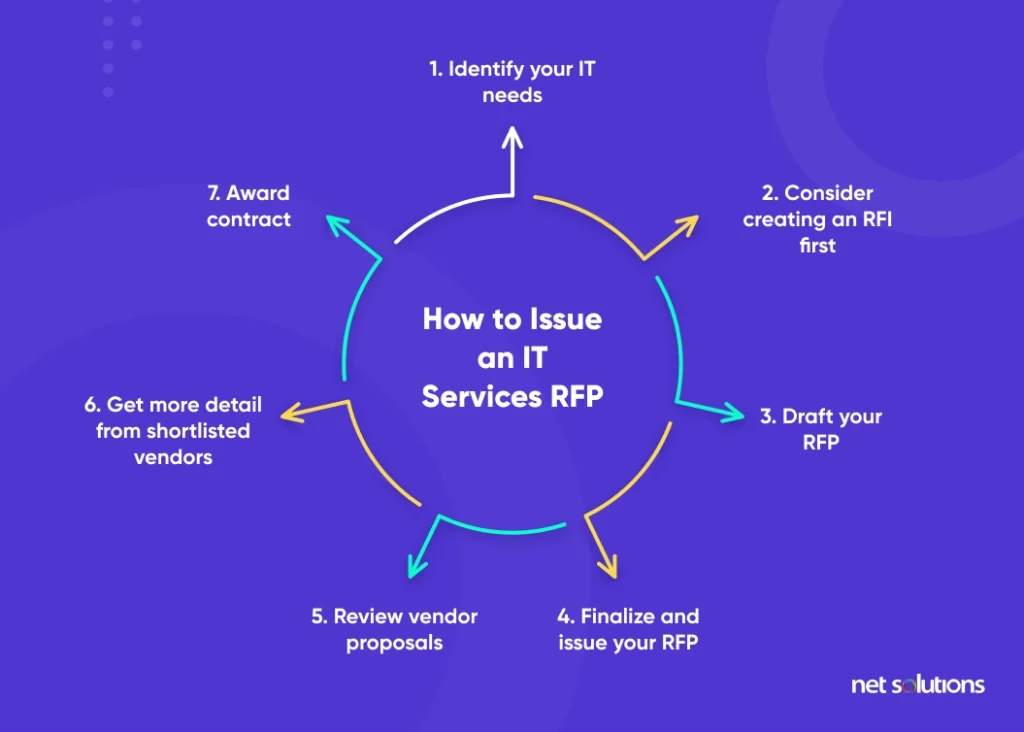
1. Identify your IT needs
What kind of IT services does your organization require? It’s important to identify all your needs before you start writing, that way you can solicit bids from companies that provide those services and have a proven track record.
IT services that companies commonly outsource include:
- Technical support
- IT security
- App modernization
- Data management and remote backup
- System monitoring
- Software licensing and support
- Data analytics (including improving reporting capabilities)
- Device management
- System upgrades
Provide a clear project overview, and consider your needs and your implementation timeframe.
2. Consider creating an RFI first
Are you still trying to wrap your head around the IT solutions your company needs?
The list above might seem intimidating, and if you’re not sure where to begin or which solutions you need, writing and distributing a Request for Information (RFI) can help you figure that out.
3. Draft your RFP
Your RFP should cover all the pertinent details outlined above, from your company information to the types of services you require.
Incorporate everything you’ve learned from your stakeholder meetings, along with anything you discovered from your RFI, if you chose to issue one.
This stage might require some back-and-forth between different stakeholders, so it often makes sense to use an editable, shared document that facilitates easy collaboration.
4. Finalize and issue your RFP
Getting your RFP right is important, so be sure you’ve got the buy-in from key stakeholders and leadership.
Before you send out the RFP to potential vendors, make sure you’ve taken the following steps:
- Get sign-off from all decision-makers
- Establish scoring criteria that you’ll use to evaluate bids
- Identify which potential vendors will receive your RFP
- Ensure there is a process for responding to questions from prospective vendors
5. Review vendor proposals
After you’ve received proposals from different vendors and the deadline for submissions has closed, it’s time to implement your scoring system. You can use a simple weighted-criteria matrix that you build in Excel, scoring proposals based on how well they fit your needs.
Obviously, if a vendor has a strong track record in one area but comes up extremely short in another, you’ll have to use some discretion in picking your top candidates—so don’t just make your decision based on total scores.
Place the top candidates on a shortlist and move on to the next step.
6. Get more detail from shortlisted vendors
Gather more detailed information from your top vendors, and set up interviews to speak with them directly. Here are a few tips to help you cover the right topics during your interviews.
Be sure to assess each shortlisted vendor for their:
- Technical expertise
- Communication skills (especially important for overseas vendors)
- Experience
- Flexibility and willingness to work with your team
- Willingness to offer new solutions and outside-the-box- thinking
- Any other factors you consider a priority
For a more detailed list of questions to ask and other steps to take during the RFP process, check out our ultimate outsourcing checklist.
7. Award contract
Once you’ve selected a vendor, it’s time to hash out the details and write up contracts. This will often involve Service Level Agreements (SLAs) and other contracts that establish the scope of work, rates, and other pertinent details.
Once everyone has signed on the dotted line, be sure to reach out and let the other shortlisted candidates know that you’ve made a decision. It’s ideal to maintain a good relationship with your other prospects, since you may choose to switch vendors down the line.
By following these steps, you will increase your odds of finding an outsourcing partner that fits your needs in terms of experience, flexibility, budget, and expertise.
Looking for a talented IT Services Provider?
Net Solutions has been in the IT services business for decades, building software and providing support for leading organizations like the Harvard Business Review and American Golf.
We also work with scrappy startups and midsize companies, and we can help you build an IT infrastructure that supports innovation and growth.
Frequently Asked Questions
Given the competitive landscape in business, you’d want to ensure you’ve aced filling up the details on an RFP. Keep these things in mind:
Be direct and clear in your answers. Don’t indulge in unnecessary details or jargon.
Address the pain point, the services, the goals, and the customer’s services – ensure they know you understand and can address their problem.
Ensure that your proposal documents are visually appealing.
Use data/statistics to support your statements.
You can use any format you’d like to solicit bids from potential vendors, but make sure it’s easy to complete and submit electronically.
An MS Word document or a custom-built online form will work fine. You can use companies like FormSwift to create online forms.
Choose evaluation criteria that align with your project goals, such as vendor experience, technical expertise, proposed solution, pricing, references, delivery timeline, and ongoing support capabilities.
- Use of vague, unclear language.
- Failing to thoroughly research the market and the vendors
- Overemphasis on Price
- Excessive Complexity
- Unrealistic Timelines

